ECON 101: Analysis of Australian Government Fiscal Policy
VerifiedAdded on 2019/10/30
|16
|3811
|159
Essay
AI Summary
This essay provides a comprehensive analysis of the fiscal policy implemented by the Australian government over the past five years, focusing on its impact on key macroeconomic indicators. It examines the government's use of both expansionary and contractionary fiscal policies to manage the eco...
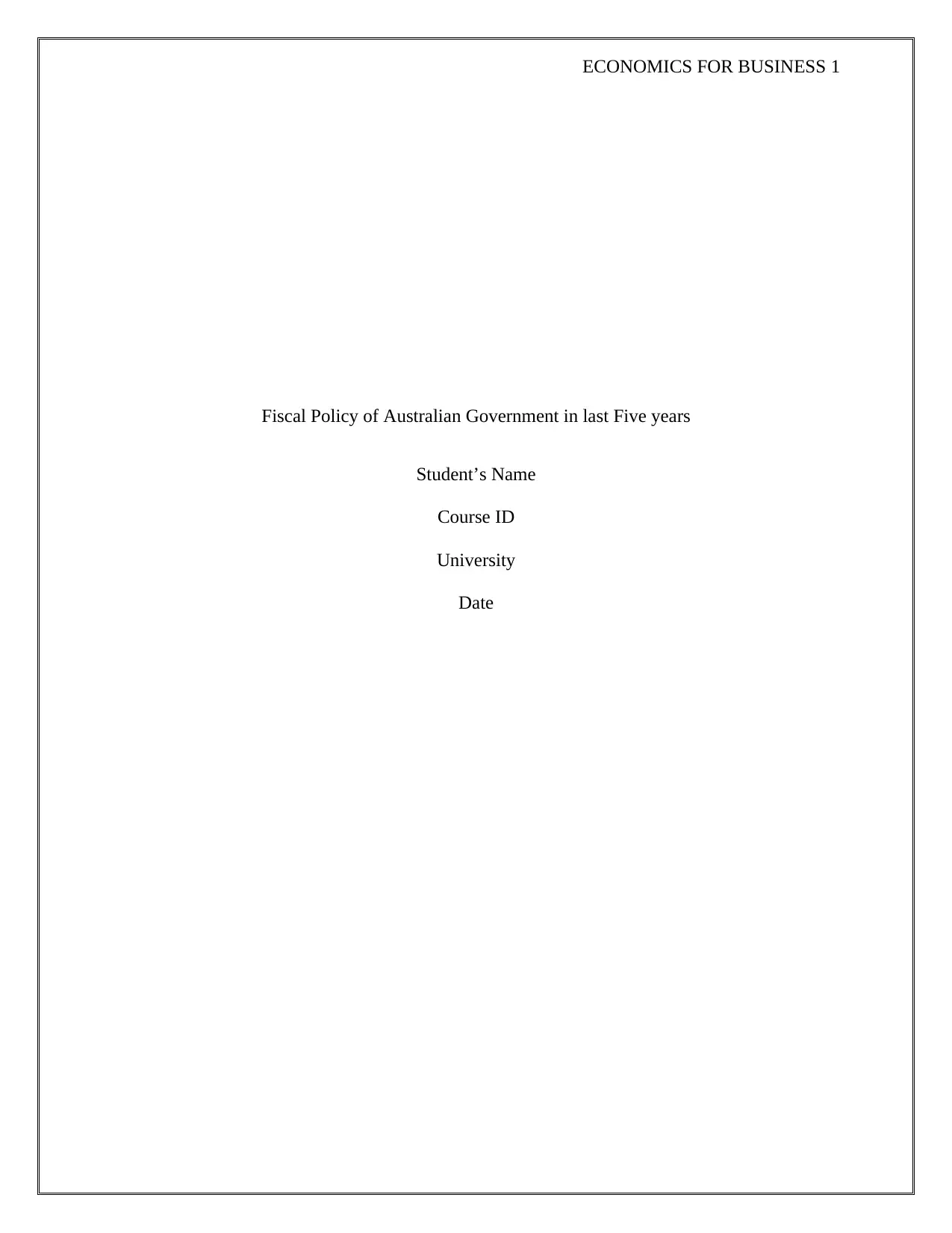
ECONOMICS FOR BUSINESS 1
Fiscal Policy of Australian Government in last Five years
Student’s Name
Course ID
University
Date
Fiscal Policy of Australian Government in last Five years
Student’s Name
Course ID
University
Date
Secure Best Marks with AI Grader
Need help grading? Try our AI Grader for instant feedback on your assignments.
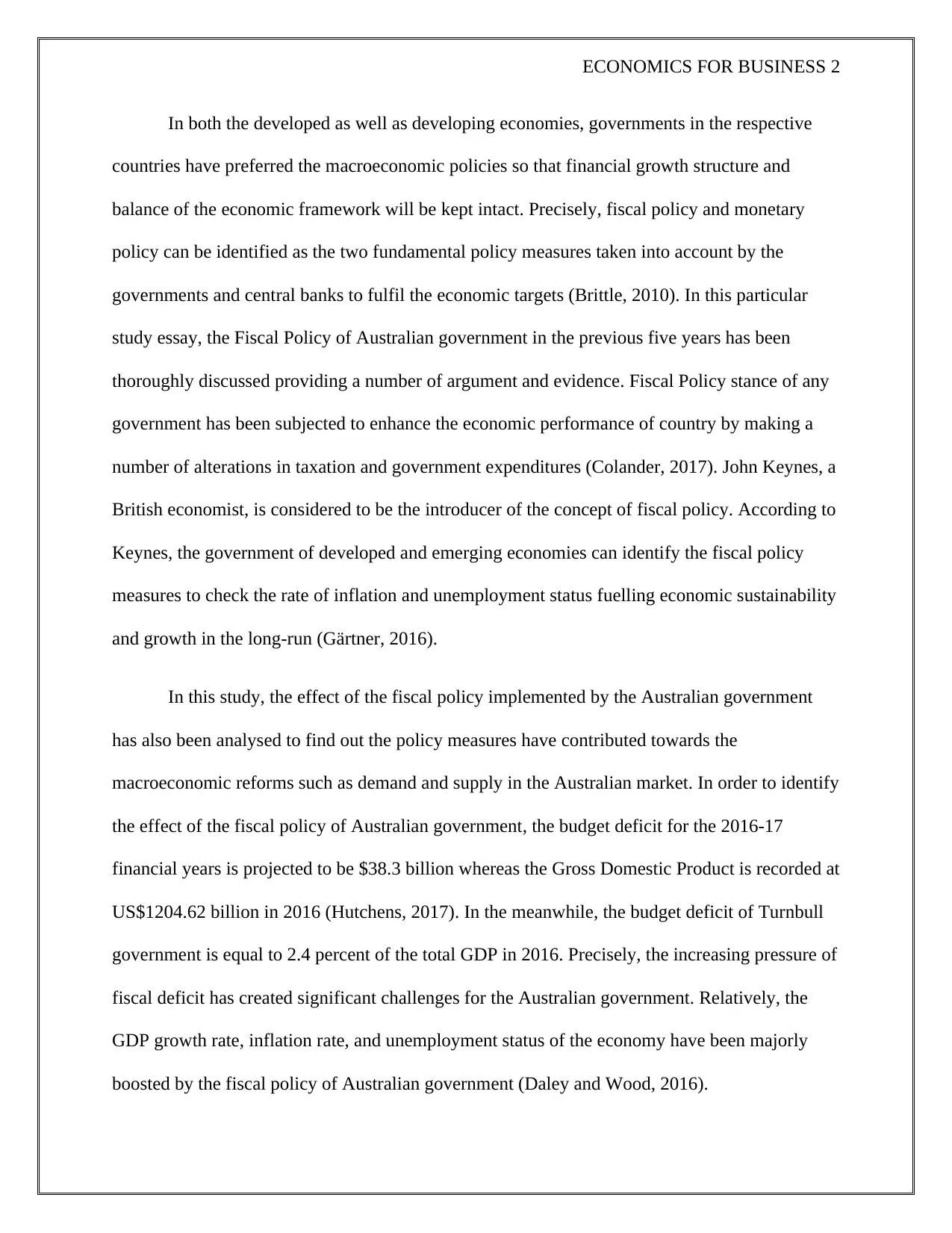
ECONOMICS FOR BUSINESS 2
In both the developed as well as developing economies, governments in the respective
countries have preferred the macroeconomic policies so that financial growth structure and
balance of the economic framework will be kept intact. Precisely, fiscal policy and monetary
policy can be identified as the two fundamental policy measures taken into account by the
governments and central banks to fulfil the economic targets (Brittle, 2010). In this particular
study essay, the Fiscal Policy of Australian government in the previous five years has been
thoroughly discussed providing a number of argument and evidence. Fiscal Policy stance of any
government has been subjected to enhance the economic performance of country by making a
number of alterations in taxation and government expenditures (Colander, 2017). John Keynes, a
British economist, is considered to be the introducer of the concept of fiscal policy. According to
Keynes, the government of developed and emerging economies can identify the fiscal policy
measures to check the rate of inflation and unemployment status fuelling economic sustainability
and growth in the long-run (Gärtner, 2016).
In this study, the effect of the fiscal policy implemented by the Australian government
has also been analysed to find out the policy measures have contributed towards the
macroeconomic reforms such as demand and supply in the Australian market. In order to identify
the effect of the fiscal policy of Australian government, the budget deficit for the 2016-17
financial years is projected to be $38.3 billion whereas the Gross Domestic Product is recorded at
US$1204.62 billion in 2016 (Hutchens, 2017). In the meanwhile, the budget deficit of Turnbull
government is equal to 2.4 percent of the total GDP in 2016. Precisely, the increasing pressure of
fiscal deficit has created significant challenges for the Australian government. Relatively, the
GDP growth rate, inflation rate, and unemployment status of the economy have been majorly
boosted by the fiscal policy of Australian government (Daley and Wood, 2016).
In both the developed as well as developing economies, governments in the respective
countries have preferred the macroeconomic policies so that financial growth structure and
balance of the economic framework will be kept intact. Precisely, fiscal policy and monetary
policy can be identified as the two fundamental policy measures taken into account by the
governments and central banks to fulfil the economic targets (Brittle, 2010). In this particular
study essay, the Fiscal Policy of Australian government in the previous five years has been
thoroughly discussed providing a number of argument and evidence. Fiscal Policy stance of any
government has been subjected to enhance the economic performance of country by making a
number of alterations in taxation and government expenditures (Colander, 2017). John Keynes, a
British economist, is considered to be the introducer of the concept of fiscal policy. According to
Keynes, the government of developed and emerging economies can identify the fiscal policy
measures to check the rate of inflation and unemployment status fuelling economic sustainability
and growth in the long-run (Gärtner, 2016).
In this study, the effect of the fiscal policy implemented by the Australian government
has also been analysed to find out the policy measures have contributed towards the
macroeconomic reforms such as demand and supply in the Australian market. In order to identify
the effect of the fiscal policy of Australian government, the budget deficit for the 2016-17
financial years is projected to be $38.3 billion whereas the Gross Domestic Product is recorded at
US$1204.62 billion in 2016 (Hutchens, 2017). In the meanwhile, the budget deficit of Turnbull
government is equal to 2.4 percent of the total GDP in 2016. Precisely, the increasing pressure of
fiscal deficit has created significant challenges for the Australian government. Relatively, the
GDP growth rate, inflation rate, and unemployment status of the economy have been majorly
boosted by the fiscal policy of Australian government (Daley and Wood, 2016).
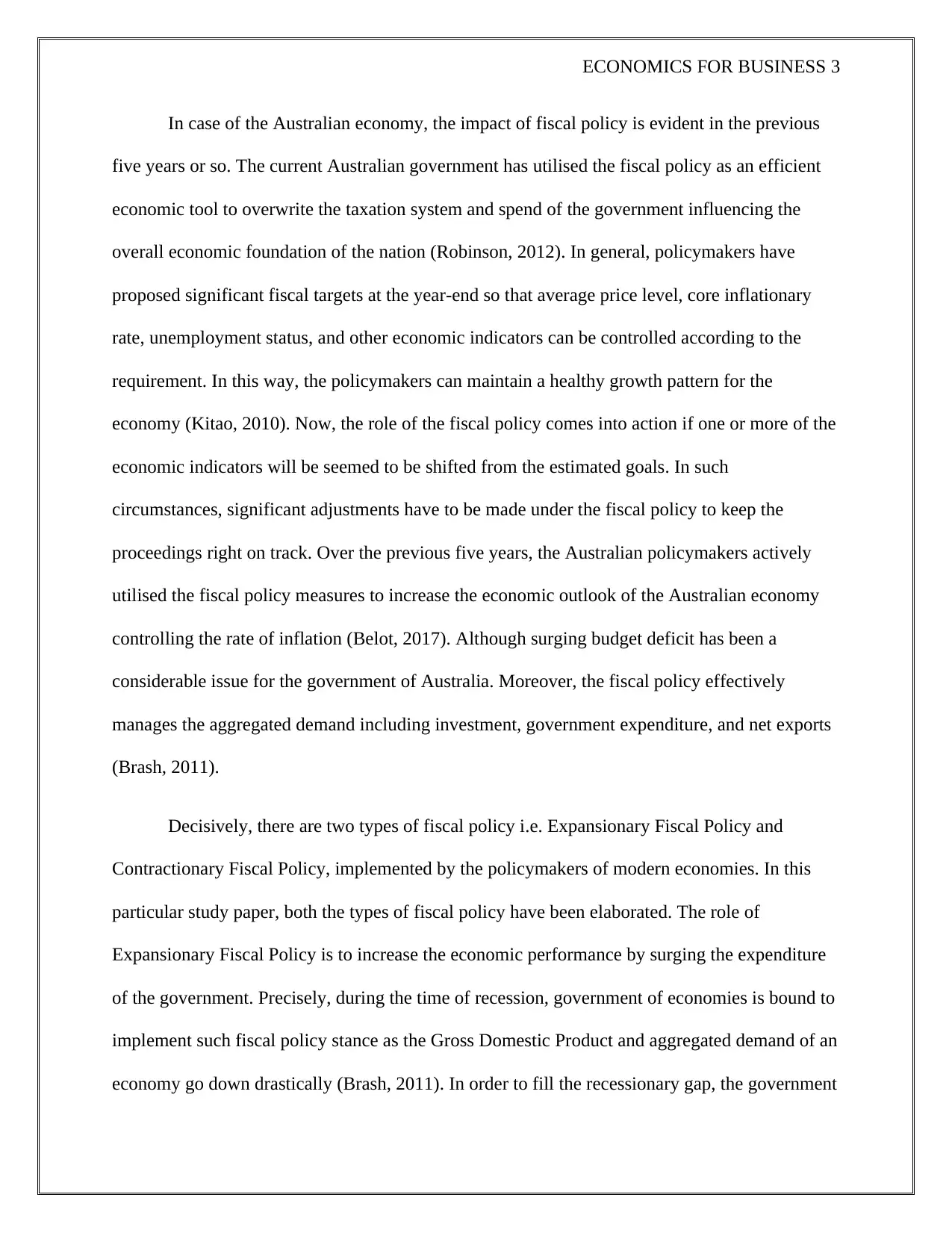
ECONOMICS FOR BUSINESS 3
In case of the Australian economy, the impact of fiscal policy is evident in the previous
five years or so. The current Australian government has utilised the fiscal policy as an efficient
economic tool to overwrite the taxation system and spend of the government influencing the
overall economic foundation of the nation (Robinson, 2012). In general, policymakers have
proposed significant fiscal targets at the year-end so that average price level, core inflationary
rate, unemployment status, and other economic indicators can be controlled according to the
requirement. In this way, the policymakers can maintain a healthy growth pattern for the
economy (Kitao, 2010). Now, the role of the fiscal policy comes into action if one or more of the
economic indicators will be seemed to be shifted from the estimated goals. In such
circumstances, significant adjustments have to be made under the fiscal policy to keep the
proceedings right on track. Over the previous five years, the Australian policymakers actively
utilised the fiscal policy measures to increase the economic outlook of the Australian economy
controlling the rate of inflation (Belot, 2017). Although surging budget deficit has been a
considerable issue for the government of Australia. Moreover, the fiscal policy effectively
manages the aggregated demand including investment, government expenditure, and net exports
(Brash, 2011).
Decisively, there are two types of fiscal policy i.e. Expansionary Fiscal Policy and
Contractionary Fiscal Policy, implemented by the policymakers of modern economies. In this
particular study paper, both the types of fiscal policy have been elaborated. The role of
Expansionary Fiscal Policy is to increase the economic performance by surging the expenditure
of the government. Precisely, during the time of recession, government of economies is bound to
implement such fiscal policy stance as the Gross Domestic Product and aggregated demand of an
economy go down drastically (Brash, 2011). In order to fill the recessionary gap, the government
In case of the Australian economy, the impact of fiscal policy is evident in the previous
five years or so. The current Australian government has utilised the fiscal policy as an efficient
economic tool to overwrite the taxation system and spend of the government influencing the
overall economic foundation of the nation (Robinson, 2012). In general, policymakers have
proposed significant fiscal targets at the year-end so that average price level, core inflationary
rate, unemployment status, and other economic indicators can be controlled according to the
requirement. In this way, the policymakers can maintain a healthy growth pattern for the
economy (Kitao, 2010). Now, the role of the fiscal policy comes into action if one or more of the
economic indicators will be seemed to be shifted from the estimated goals. In such
circumstances, significant adjustments have to be made under the fiscal policy to keep the
proceedings right on track. Over the previous five years, the Australian policymakers actively
utilised the fiscal policy measures to increase the economic outlook of the Australian economy
controlling the rate of inflation (Belot, 2017). Although surging budget deficit has been a
considerable issue for the government of Australia. Moreover, the fiscal policy effectively
manages the aggregated demand including investment, government expenditure, and net exports
(Brash, 2011).
Decisively, there are two types of fiscal policy i.e. Expansionary Fiscal Policy and
Contractionary Fiscal Policy, implemented by the policymakers of modern economies. In this
particular study paper, both the types of fiscal policy have been elaborated. The role of
Expansionary Fiscal Policy is to increase the economic performance by surging the expenditure
of the government. Precisely, during the time of recession, government of economies is bound to
implement such fiscal policy stance as the Gross Domestic Product and aggregated demand of an
economy go down drastically (Brash, 2011). In order to fill the recessionary gap, the government
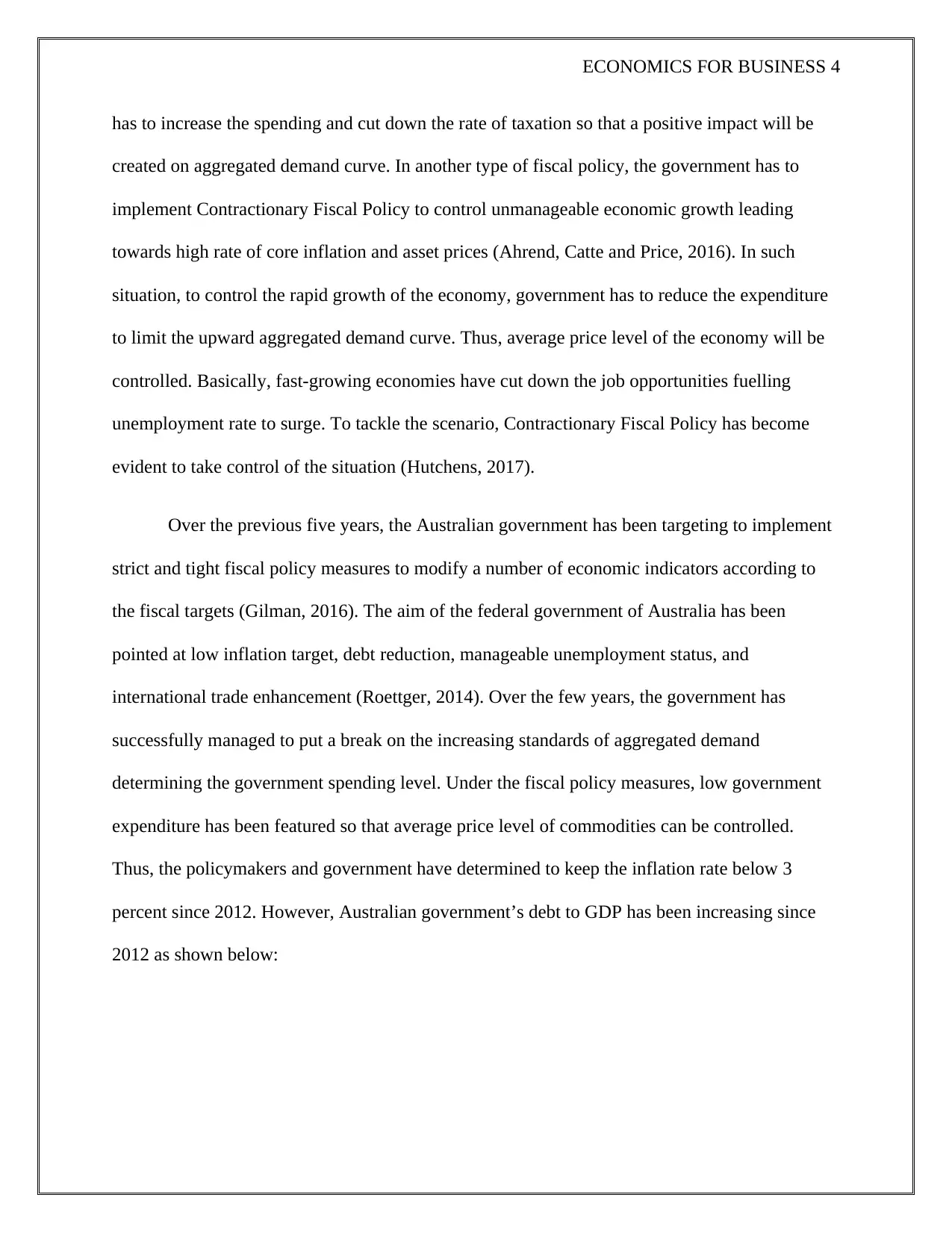
ECONOMICS FOR BUSINESS 4
has to increase the spending and cut down the rate of taxation so that a positive impact will be
created on aggregated demand curve. In another type of fiscal policy, the government has to
implement Contractionary Fiscal Policy to control unmanageable economic growth leading
towards high rate of core inflation and asset prices (Ahrend, Catte and Price, 2016). In such
situation, to control the rapid growth of the economy, government has to reduce the expenditure
to limit the upward aggregated demand curve. Thus, average price level of the economy will be
controlled. Basically, fast-growing economies have cut down the job opportunities fuelling
unemployment rate to surge. To tackle the scenario, Contractionary Fiscal Policy has become
evident to take control of the situation (Hutchens, 2017).
Over the previous five years, the Australian government has been targeting to implement
strict and tight fiscal policy measures to modify a number of economic indicators according to
the fiscal targets (Gilman, 2016). The aim of the federal government of Australia has been
pointed at low inflation target, debt reduction, manageable unemployment status, and
international trade enhancement (Roettger, 2014). Over the few years, the government has
successfully managed to put a break on the increasing standards of aggregated demand
determining the government spending level. Under the fiscal policy measures, low government
expenditure has been featured so that average price level of commodities can be controlled.
Thus, the policymakers and government have determined to keep the inflation rate below 3
percent since 2012. However, Australian government’s debt to GDP has been increasing since
2012 as shown below:
has to increase the spending and cut down the rate of taxation so that a positive impact will be
created on aggregated demand curve. In another type of fiscal policy, the government has to
implement Contractionary Fiscal Policy to control unmanageable economic growth leading
towards high rate of core inflation and asset prices (Ahrend, Catte and Price, 2016). In such
situation, to control the rapid growth of the economy, government has to reduce the expenditure
to limit the upward aggregated demand curve. Thus, average price level of the economy will be
controlled. Basically, fast-growing economies have cut down the job opportunities fuelling
unemployment rate to surge. To tackle the scenario, Contractionary Fiscal Policy has become
evident to take control of the situation (Hutchens, 2017).
Over the previous five years, the Australian government has been targeting to implement
strict and tight fiscal policy measures to modify a number of economic indicators according to
the fiscal targets (Gilman, 2016). The aim of the federal government of Australia has been
pointed at low inflation target, debt reduction, manageable unemployment status, and
international trade enhancement (Roettger, 2014). Over the few years, the government has
successfully managed to put a break on the increasing standards of aggregated demand
determining the government spending level. Under the fiscal policy measures, low government
expenditure has been featured so that average price level of commodities can be controlled.
Thus, the policymakers and government have determined to keep the inflation rate below 3
percent since 2012. However, Australian government’s debt to GDP has been increasing since
2012 as shown below:
Secure Best Marks with AI Grader
Need help grading? Try our AI Grader for instant feedback on your assignments.
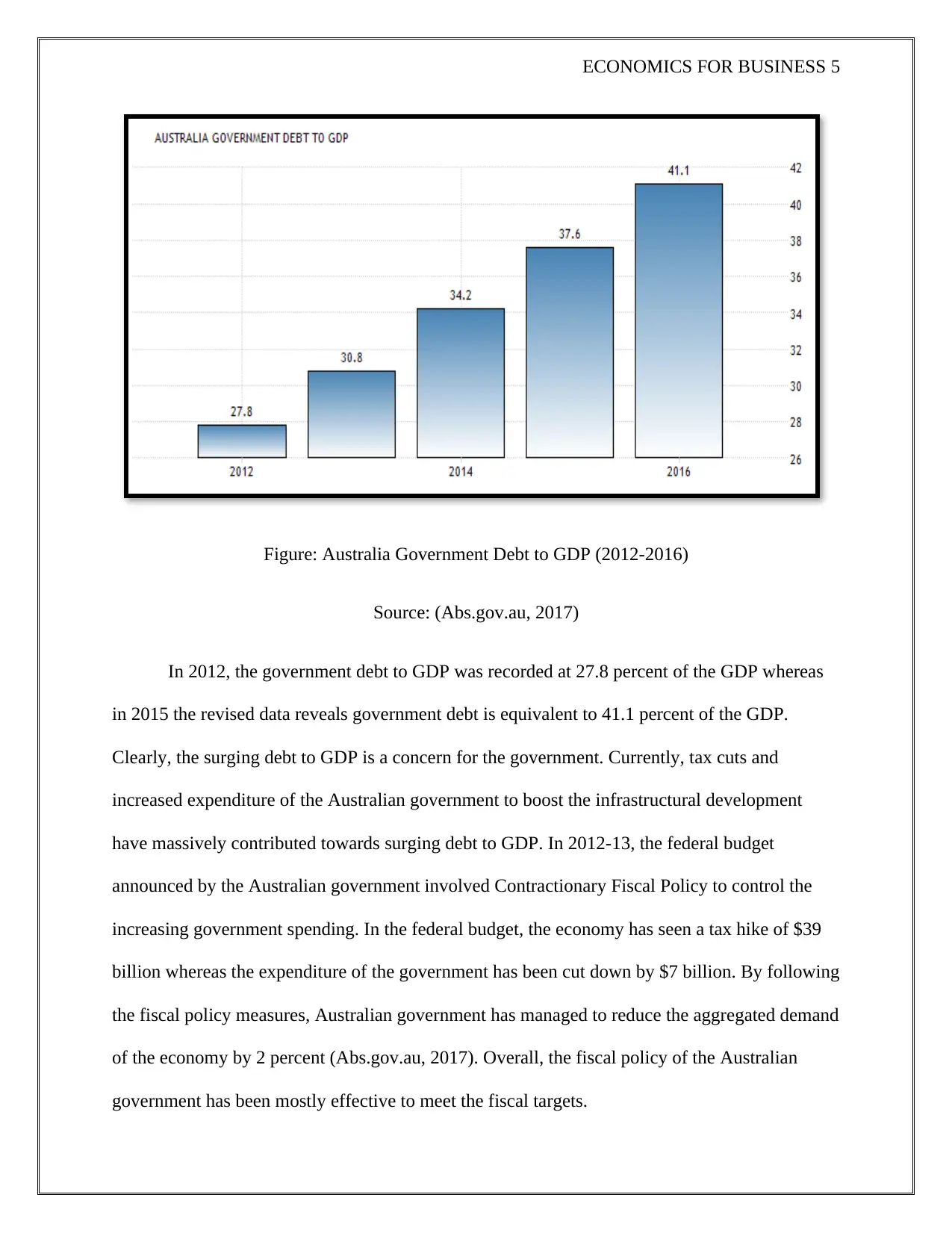
ECONOMICS FOR BUSINESS 5
Figure: Australia Government Debt to GDP (2012-2016)
Source: (Abs.gov.au, 2017)
In 2012, the government debt to GDP was recorded at 27.8 percent of the GDP whereas
in 2015 the revised data reveals government debt is equivalent to 41.1 percent of the GDP.
Clearly, the surging debt to GDP is a concern for the government. Currently, tax cuts and
increased expenditure of the Australian government to boost the infrastructural development
have massively contributed towards surging debt to GDP. In 2012-13, the federal budget
announced by the Australian government involved Contractionary Fiscal Policy to control the
increasing government spending. In the federal budget, the economy has seen a tax hike of $39
billion whereas the expenditure of the government has been cut down by $7 billion. By following
the fiscal policy measures, Australian government has managed to reduce the aggregated demand
of the economy by 2 percent (Abs.gov.au, 2017). Overall, the fiscal policy of the Australian
government has been mostly effective to meet the fiscal targets.
Figure: Australia Government Debt to GDP (2012-2016)
Source: (Abs.gov.au, 2017)
In 2012, the government debt to GDP was recorded at 27.8 percent of the GDP whereas
in 2015 the revised data reveals government debt is equivalent to 41.1 percent of the GDP.
Clearly, the surging debt to GDP is a concern for the government. Currently, tax cuts and
increased expenditure of the Australian government to boost the infrastructural development
have massively contributed towards surging debt to GDP. In 2012-13, the federal budget
announced by the Australian government involved Contractionary Fiscal Policy to control the
increasing government spending. In the federal budget, the economy has seen a tax hike of $39
billion whereas the expenditure of the government has been cut down by $7 billion. By following
the fiscal policy measures, Australian government has managed to reduce the aggregated demand
of the economy by 2 percent (Abs.gov.au, 2017). Overall, the fiscal policy of the Australian
government has been mostly effective to meet the fiscal targets.
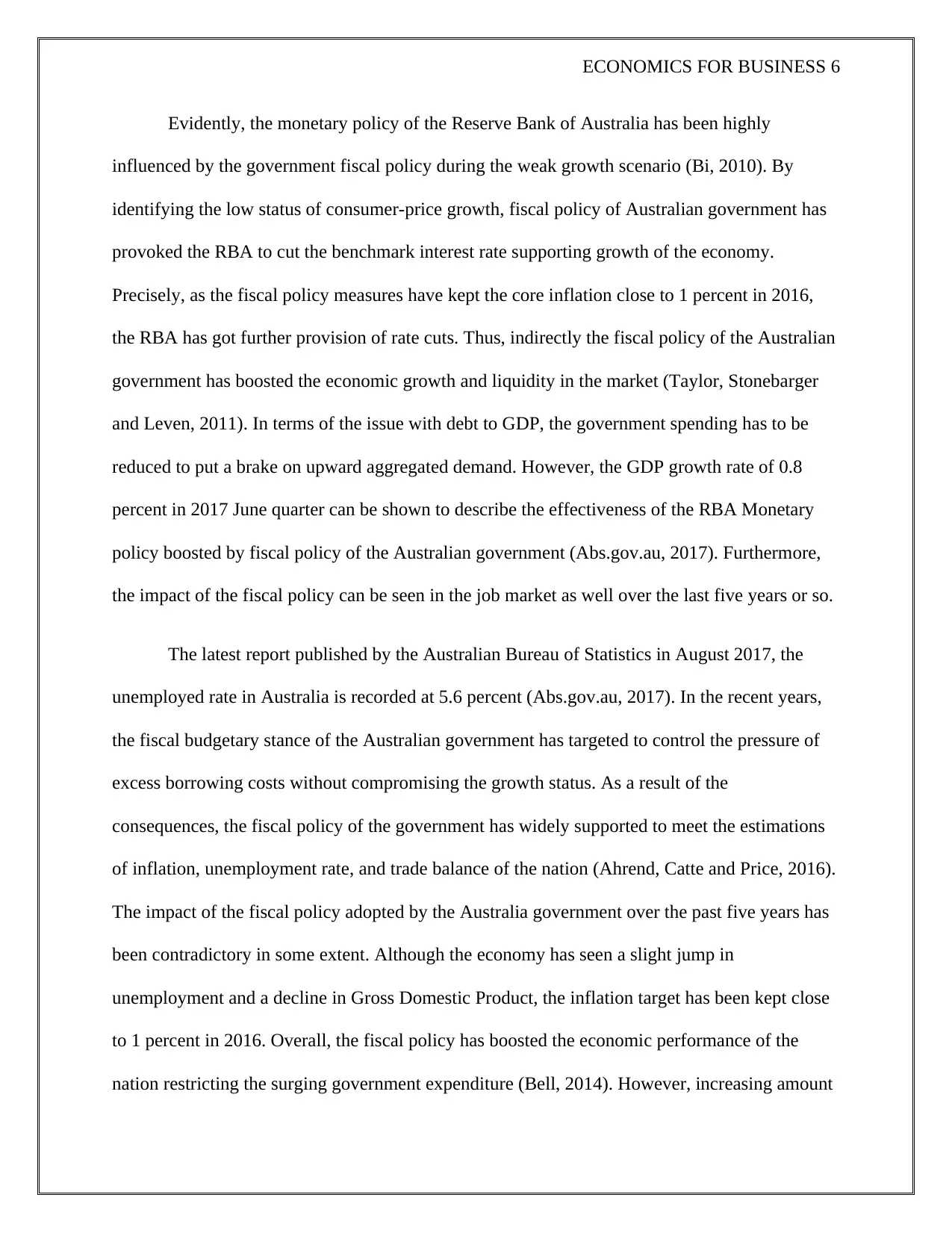
ECONOMICS FOR BUSINESS 6
Evidently, the monetary policy of the Reserve Bank of Australia has been highly
influenced by the government fiscal policy during the weak growth scenario (Bi, 2010). By
identifying the low status of consumer-price growth, fiscal policy of Australian government has
provoked the RBA to cut the benchmark interest rate supporting growth of the economy.
Precisely, as the fiscal policy measures have kept the core inflation close to 1 percent in 2016,
the RBA has got further provision of rate cuts. Thus, indirectly the fiscal policy of the Australian
government has boosted the economic growth and liquidity in the market (Taylor, Stonebarger
and Leven, 2011). In terms of the issue with debt to GDP, the government spending has to be
reduced to put a brake on upward aggregated demand. However, the GDP growth rate of 0.8
percent in 2017 June quarter can be shown to describe the effectiveness of the RBA Monetary
policy boosted by fiscal policy of the Australian government (Abs.gov.au, 2017). Furthermore,
the impact of the fiscal policy can be seen in the job market as well over the last five years or so.
The latest report published by the Australian Bureau of Statistics in August 2017, the
unemployed rate in Australia is recorded at 5.6 percent (Abs.gov.au, 2017). In the recent years,
the fiscal budgetary stance of the Australian government has targeted to control the pressure of
excess borrowing costs without compromising the growth status. As a result of the
consequences, the fiscal policy of the government has widely supported to meet the estimations
of inflation, unemployment rate, and trade balance of the nation (Ahrend, Catte and Price, 2016).
The impact of the fiscal policy adopted by the Australia government over the past five years has
been contradictory in some extent. Although the economy has seen a slight jump in
unemployment and a decline in Gross Domestic Product, the inflation target has been kept close
to 1 percent in 2016. Overall, the fiscal policy has boosted the economic performance of the
nation restricting the surging government expenditure (Bell, 2014). However, increasing amount
Evidently, the monetary policy of the Reserve Bank of Australia has been highly
influenced by the government fiscal policy during the weak growth scenario (Bi, 2010). By
identifying the low status of consumer-price growth, fiscal policy of Australian government has
provoked the RBA to cut the benchmark interest rate supporting growth of the economy.
Precisely, as the fiscal policy measures have kept the core inflation close to 1 percent in 2016,
the RBA has got further provision of rate cuts. Thus, indirectly the fiscal policy of the Australian
government has boosted the economic growth and liquidity in the market (Taylor, Stonebarger
and Leven, 2011). In terms of the issue with debt to GDP, the government spending has to be
reduced to put a brake on upward aggregated demand. However, the GDP growth rate of 0.8
percent in 2017 June quarter can be shown to describe the effectiveness of the RBA Monetary
policy boosted by fiscal policy of the Australian government (Abs.gov.au, 2017). Furthermore,
the impact of the fiscal policy can be seen in the job market as well over the last five years or so.
The latest report published by the Australian Bureau of Statistics in August 2017, the
unemployed rate in Australia is recorded at 5.6 percent (Abs.gov.au, 2017). In the recent years,
the fiscal budgetary stance of the Australian government has targeted to control the pressure of
excess borrowing costs without compromising the growth status. As a result of the
consequences, the fiscal policy of the government has widely supported to meet the estimations
of inflation, unemployment rate, and trade balance of the nation (Ahrend, Catte and Price, 2016).
The impact of the fiscal policy adopted by the Australia government over the past five years has
been contradictory in some extent. Although the economy has seen a slight jump in
unemployment and a decline in Gross Domestic Product, the inflation target has been kept close
to 1 percent in 2016. Overall, the fiscal policy has boosted the economic performance of the
nation restricting the surging government expenditure (Bell, 2014). However, increasing amount
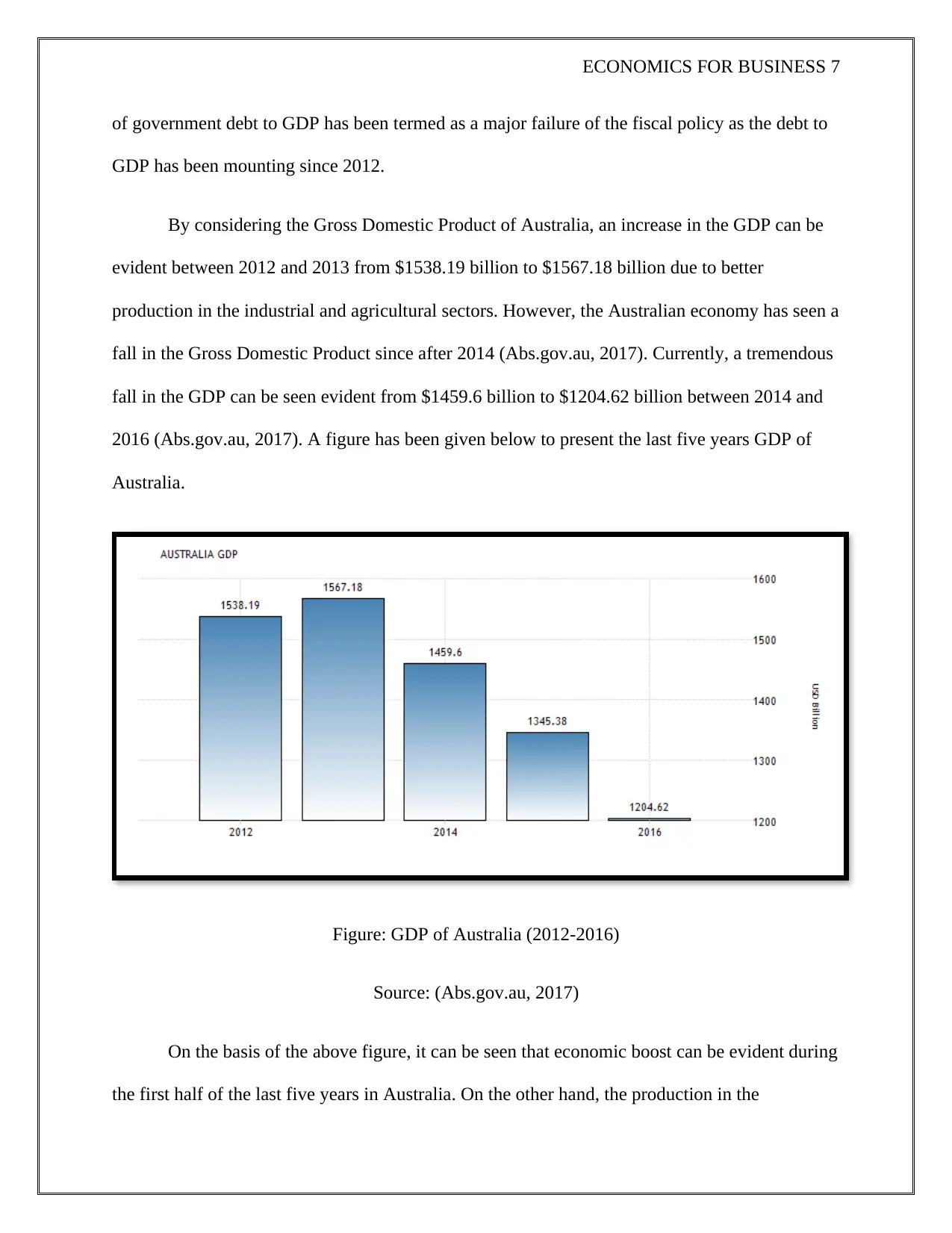
ECONOMICS FOR BUSINESS 7
of government debt to GDP has been termed as a major failure of the fiscal policy as the debt to
GDP has been mounting since 2012.
By considering the Gross Domestic Product of Australia, an increase in the GDP can be
evident between 2012 and 2013 from $1538.19 billion to $1567.18 billion due to better
production in the industrial and agricultural sectors. However, the Australian economy has seen a
fall in the Gross Domestic Product since after 2014 (Abs.gov.au, 2017). Currently, a tremendous
fall in the GDP can be seen evident from $1459.6 billion to $1204.62 billion between 2014 and
2016 (Abs.gov.au, 2017). A figure has been given below to present the last five years GDP of
Australia.
Figure: GDP of Australia (2012-2016)
Source: (Abs.gov.au, 2017)
On the basis of the above figure, it can be seen that economic boost can be evident during
the first half of the last five years in Australia. On the other hand, the production in the
of government debt to GDP has been termed as a major failure of the fiscal policy as the debt to
GDP has been mounting since 2012.
By considering the Gross Domestic Product of Australia, an increase in the GDP can be
evident between 2012 and 2013 from $1538.19 billion to $1567.18 billion due to better
production in the industrial and agricultural sectors. However, the Australian economy has seen a
fall in the Gross Domestic Product since after 2014 (Abs.gov.au, 2017). Currently, a tremendous
fall in the GDP can be seen evident from $1459.6 billion to $1204.62 billion between 2014 and
2016 (Abs.gov.au, 2017). A figure has been given below to present the last five years GDP of
Australia.
Figure: GDP of Australia (2012-2016)
Source: (Abs.gov.au, 2017)
On the basis of the above figure, it can be seen that economic boost can be evident during
the first half of the last five years in Australia. On the other hand, the production in the
Paraphrase This Document
Need a fresh take? Get an instant paraphrase of this document with our AI Paraphraser
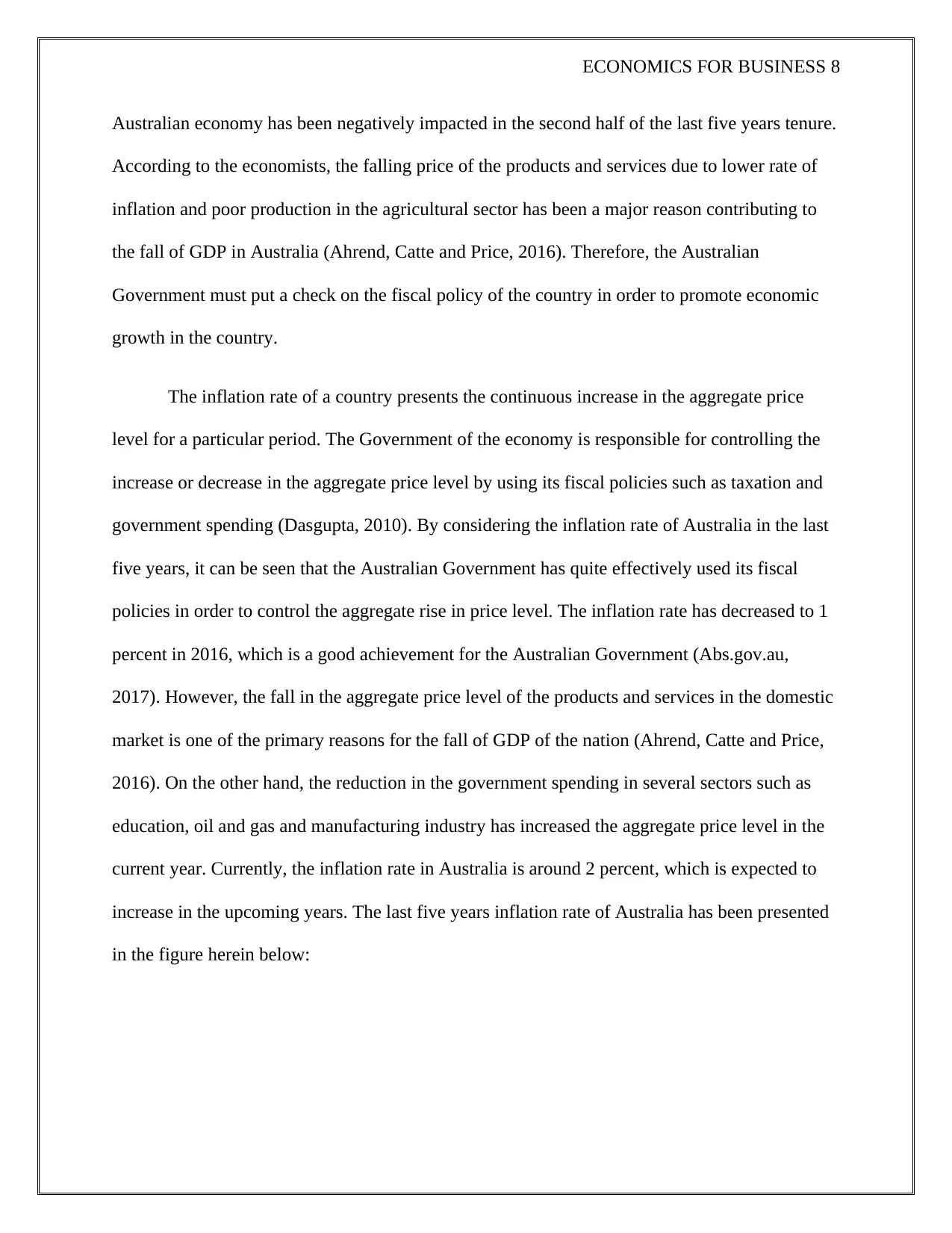
ECONOMICS FOR BUSINESS 8
Australian economy has been negatively impacted in the second half of the last five years tenure.
According to the economists, the falling price of the products and services due to lower rate of
inflation and poor production in the agricultural sector has been a major reason contributing to
the fall of GDP in Australia (Ahrend, Catte and Price, 2016). Therefore, the Australian
Government must put a check on the fiscal policy of the country in order to promote economic
growth in the country.
The inflation rate of a country presents the continuous increase in the aggregate price
level for a particular period. The Government of the economy is responsible for controlling the
increase or decrease in the aggregate price level by using its fiscal policies such as taxation and
government spending (Dasgupta, 2010). By considering the inflation rate of Australia in the last
five years, it can be seen that the Australian Government has quite effectively used its fiscal
policies in order to control the aggregate rise in price level. The inflation rate has decreased to 1
percent in 2016, which is a good achievement for the Australian Government (Abs.gov.au,
2017). However, the fall in the aggregate price level of the products and services in the domestic
market is one of the primary reasons for the fall of GDP of the nation (Ahrend, Catte and Price,
2016). On the other hand, the reduction in the government spending in several sectors such as
education, oil and gas and manufacturing industry has increased the aggregate price level in the
current year. Currently, the inflation rate in Australia is around 2 percent, which is expected to
increase in the upcoming years. The last five years inflation rate of Australia has been presented
in the figure herein below:
Australian economy has been negatively impacted in the second half of the last five years tenure.
According to the economists, the falling price of the products and services due to lower rate of
inflation and poor production in the agricultural sector has been a major reason contributing to
the fall of GDP in Australia (Ahrend, Catte and Price, 2016). Therefore, the Australian
Government must put a check on the fiscal policy of the country in order to promote economic
growth in the country.
The inflation rate of a country presents the continuous increase in the aggregate price
level for a particular period. The Government of the economy is responsible for controlling the
increase or decrease in the aggregate price level by using its fiscal policies such as taxation and
government spending (Dasgupta, 2010). By considering the inflation rate of Australia in the last
five years, it can be seen that the Australian Government has quite effectively used its fiscal
policies in order to control the aggregate rise in price level. The inflation rate has decreased to 1
percent in 2016, which is a good achievement for the Australian Government (Abs.gov.au,
2017). However, the fall in the aggregate price level of the products and services in the domestic
market is one of the primary reasons for the fall of GDP of the nation (Ahrend, Catte and Price,
2016). On the other hand, the reduction in the government spending in several sectors such as
education, oil and gas and manufacturing industry has increased the aggregate price level in the
current year. Currently, the inflation rate in Australia is around 2 percent, which is expected to
increase in the upcoming years. The last five years inflation rate of Australia has been presented
in the figure herein below:
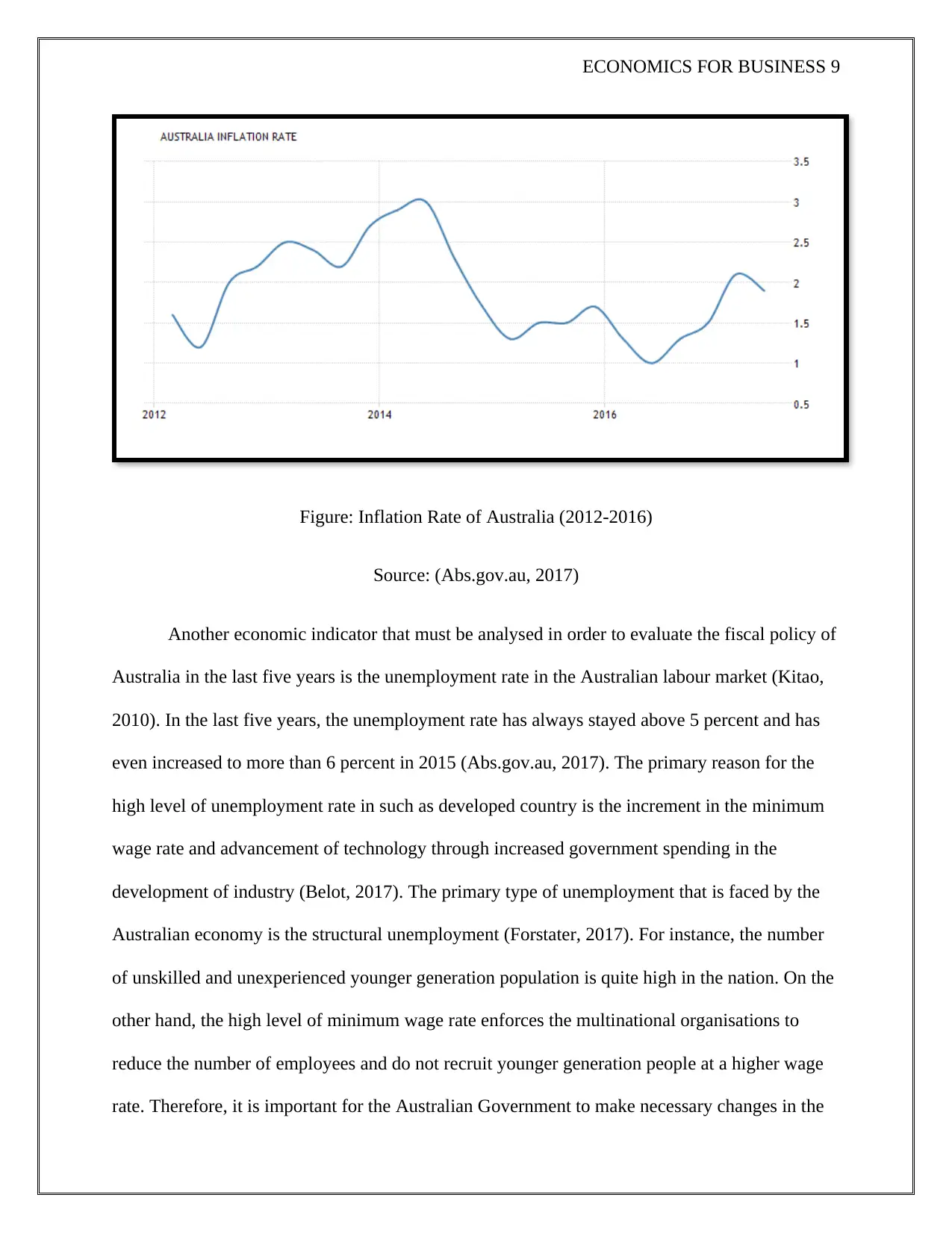
ECONOMICS FOR BUSINESS 9
Figure: Inflation Rate of Australia (2012-2016)
Source: (Abs.gov.au, 2017)
Another economic indicator that must be analysed in order to evaluate the fiscal policy of
Australia in the last five years is the unemployment rate in the Australian labour market (Kitao,
2010). In the last five years, the unemployment rate has always stayed above 5 percent and has
even increased to more than 6 percent in 2015 (Abs.gov.au, 2017). The primary reason for the
high level of unemployment rate in such as developed country is the increment in the minimum
wage rate and advancement of technology through increased government spending in the
development of industry (Belot, 2017). The primary type of unemployment that is faced by the
Australian economy is the structural unemployment (Forstater, 2017). For instance, the number
of unskilled and unexperienced younger generation population is quite high in the nation. On the
other hand, the high level of minimum wage rate enforces the multinational organisations to
reduce the number of employees and do not recruit younger generation people at a higher wage
rate. Therefore, it is important for the Australian Government to make necessary changes in the
Figure: Inflation Rate of Australia (2012-2016)
Source: (Abs.gov.au, 2017)
Another economic indicator that must be analysed in order to evaluate the fiscal policy of
Australia in the last five years is the unemployment rate in the Australian labour market (Kitao,
2010). In the last five years, the unemployment rate has always stayed above 5 percent and has
even increased to more than 6 percent in 2015 (Abs.gov.au, 2017). The primary reason for the
high level of unemployment rate in such as developed country is the increment in the minimum
wage rate and advancement of technology through increased government spending in the
development of industry (Belot, 2017). The primary type of unemployment that is faced by the
Australian economy is the structural unemployment (Forstater, 2017). For instance, the number
of unskilled and unexperienced younger generation population is quite high in the nation. On the
other hand, the high level of minimum wage rate enforces the multinational organisations to
reduce the number of employees and do not recruit younger generation people at a higher wage
rate. Therefore, it is important for the Australian Government to make necessary changes in the
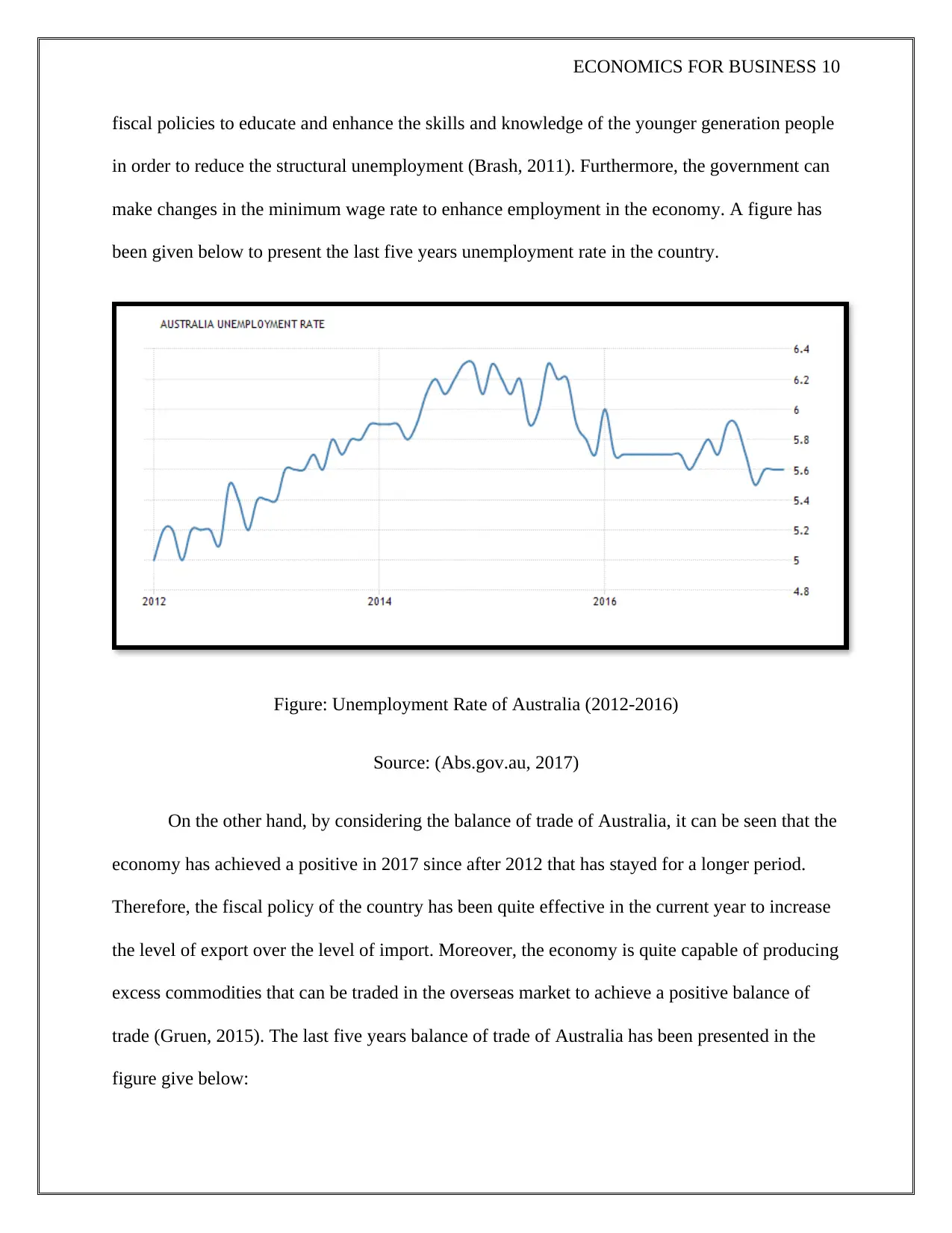
ECONOMICS FOR BUSINESS 10
fiscal policies to educate and enhance the skills and knowledge of the younger generation people
in order to reduce the structural unemployment (Brash, 2011). Furthermore, the government can
make changes in the minimum wage rate to enhance employment in the economy. A figure has
been given below to present the last five years unemployment rate in the country.
Figure: Unemployment Rate of Australia (2012-2016)
Source: (Abs.gov.au, 2017)
On the other hand, by considering the balance of trade of Australia, it can be seen that the
economy has achieved a positive in 2017 since after 2012 that has stayed for a longer period.
Therefore, the fiscal policy of the country has been quite effective in the current year to increase
the level of export over the level of import. Moreover, the economy is quite capable of producing
excess commodities that can be traded in the overseas market to achieve a positive balance of
trade (Gruen, 2015). The last five years balance of trade of Australia has been presented in the
figure give below:
fiscal policies to educate and enhance the skills and knowledge of the younger generation people
in order to reduce the structural unemployment (Brash, 2011). Furthermore, the government can
make changes in the minimum wage rate to enhance employment in the economy. A figure has
been given below to present the last five years unemployment rate in the country.
Figure: Unemployment Rate of Australia (2012-2016)
Source: (Abs.gov.au, 2017)
On the other hand, by considering the balance of trade of Australia, it can be seen that the
economy has achieved a positive in 2017 since after 2012 that has stayed for a longer period.
Therefore, the fiscal policy of the country has been quite effective in the current year to increase
the level of export over the level of import. Moreover, the economy is quite capable of producing
excess commodities that can be traded in the overseas market to achieve a positive balance of
trade (Gruen, 2015). The last five years balance of trade of Australia has been presented in the
figure give below:
Secure Best Marks with AI Grader
Need help grading? Try our AI Grader for instant feedback on your assignments.
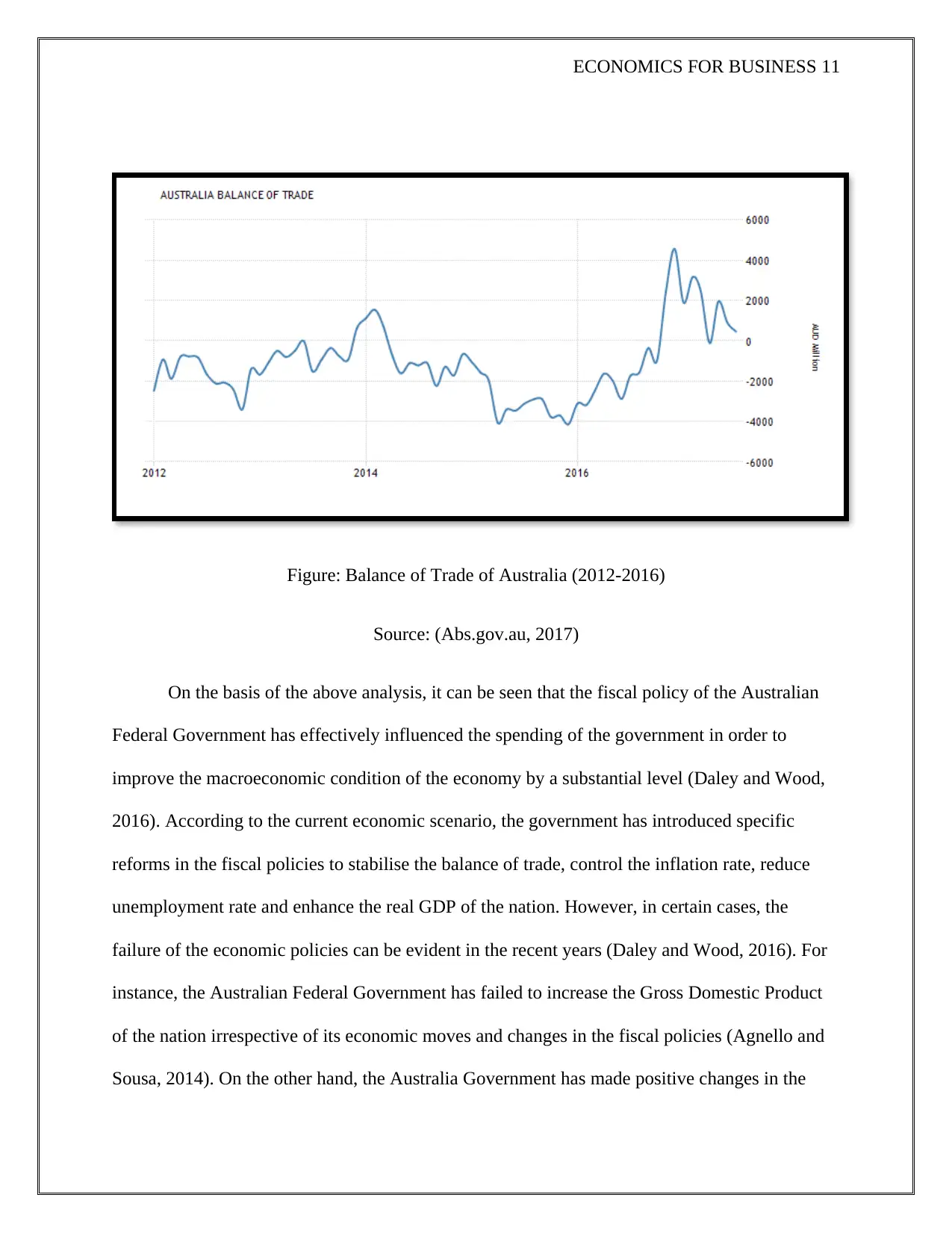
ECONOMICS FOR BUSINESS 11
Figure: Balance of Trade of Australia (2012-2016)
Source: (Abs.gov.au, 2017)
On the basis of the above analysis, it can be seen that the fiscal policy of the Australian
Federal Government has effectively influenced the spending of the government in order to
improve the macroeconomic condition of the economy by a substantial level (Daley and Wood,
2016). According to the current economic scenario, the government has introduced specific
reforms in the fiscal policies to stabilise the balance of trade, control the inflation rate, reduce
unemployment rate and enhance the real GDP of the nation. However, in certain cases, the
failure of the economic policies can be evident in the recent years (Daley and Wood, 2016). For
instance, the Australian Federal Government has failed to increase the Gross Domestic Product
of the nation irrespective of its economic moves and changes in the fiscal policies (Agnello and
Sousa, 2014). On the other hand, the Australia Government has made positive changes in the
Figure: Balance of Trade of Australia (2012-2016)
Source: (Abs.gov.au, 2017)
On the basis of the above analysis, it can be seen that the fiscal policy of the Australian
Federal Government has effectively influenced the spending of the government in order to
improve the macroeconomic condition of the economy by a substantial level (Daley and Wood,
2016). According to the current economic scenario, the government has introduced specific
reforms in the fiscal policies to stabilise the balance of trade, control the inflation rate, reduce
unemployment rate and enhance the real GDP of the nation. However, in certain cases, the
failure of the economic policies can be evident in the recent years (Daley and Wood, 2016). For
instance, the Australian Federal Government has failed to increase the Gross Domestic Product
of the nation irrespective of its economic moves and changes in the fiscal policies (Agnello and
Sousa, 2014). On the other hand, the Australia Government has made positive changes in the
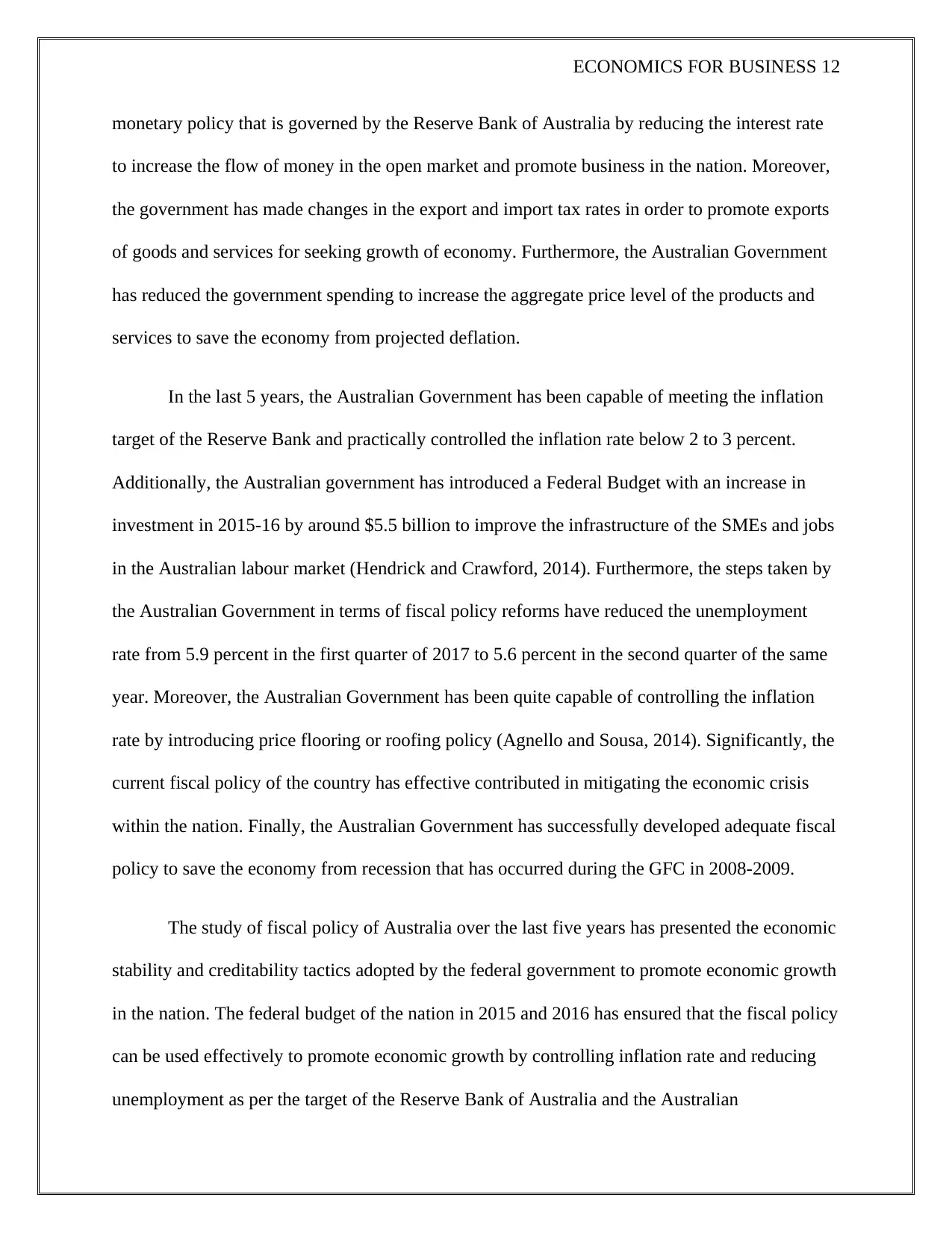
ECONOMICS FOR BUSINESS 12
monetary policy that is governed by the Reserve Bank of Australia by reducing the interest rate
to increase the flow of money in the open market and promote business in the nation. Moreover,
the government has made changes in the export and import tax rates in order to promote exports
of goods and services for seeking growth of economy. Furthermore, the Australian Government
has reduced the government spending to increase the aggregate price level of the products and
services to save the economy from projected deflation.
In the last 5 years, the Australian Government has been capable of meeting the inflation
target of the Reserve Bank and practically controlled the inflation rate below 2 to 3 percent.
Additionally, the Australian government has introduced a Federal Budget with an increase in
investment in 2015-16 by around $5.5 billion to improve the infrastructure of the SMEs and jobs
in the Australian labour market (Hendrick and Crawford, 2014). Furthermore, the steps taken by
the Australian Government in terms of fiscal policy reforms have reduced the unemployment
rate from 5.9 percent in the first quarter of 2017 to 5.6 percent in the second quarter of the same
year. Moreover, the Australian Government has been quite capable of controlling the inflation
rate by introducing price flooring or roofing policy (Agnello and Sousa, 2014). Significantly, the
current fiscal policy of the country has effective contributed in mitigating the economic crisis
within the nation. Finally, the Australian Government has successfully developed adequate fiscal
policy to save the economy from recession that has occurred during the GFC in 2008-2009.
The study of fiscal policy of Australia over the last five years has presented the economic
stability and creditability tactics adopted by the federal government to promote economic growth
in the nation. The federal budget of the nation in 2015 and 2016 has ensured that the fiscal policy
can be used effectively to promote economic growth by controlling inflation rate and reducing
unemployment as per the target of the Reserve Bank of Australia and the Australian
monetary policy that is governed by the Reserve Bank of Australia by reducing the interest rate
to increase the flow of money in the open market and promote business in the nation. Moreover,
the government has made changes in the export and import tax rates in order to promote exports
of goods and services for seeking growth of economy. Furthermore, the Australian Government
has reduced the government spending to increase the aggregate price level of the products and
services to save the economy from projected deflation.
In the last 5 years, the Australian Government has been capable of meeting the inflation
target of the Reserve Bank and practically controlled the inflation rate below 2 to 3 percent.
Additionally, the Australian government has introduced a Federal Budget with an increase in
investment in 2015-16 by around $5.5 billion to improve the infrastructure of the SMEs and jobs
in the Australian labour market (Hendrick and Crawford, 2014). Furthermore, the steps taken by
the Australian Government in terms of fiscal policy reforms have reduced the unemployment
rate from 5.9 percent in the first quarter of 2017 to 5.6 percent in the second quarter of the same
year. Moreover, the Australian Government has been quite capable of controlling the inflation
rate by introducing price flooring or roofing policy (Agnello and Sousa, 2014). Significantly, the
current fiscal policy of the country has effective contributed in mitigating the economic crisis
within the nation. Finally, the Australian Government has successfully developed adequate fiscal
policy to save the economy from recession that has occurred during the GFC in 2008-2009.
The study of fiscal policy of Australia over the last five years has presented the economic
stability and creditability tactics adopted by the federal government to promote economic growth
in the nation. The federal budget of the nation in 2015 and 2016 has ensured that the fiscal policy
can be used effectively to promote economic growth by controlling inflation rate and reducing
unemployment as per the target of the Reserve Bank of Australia and the Australian
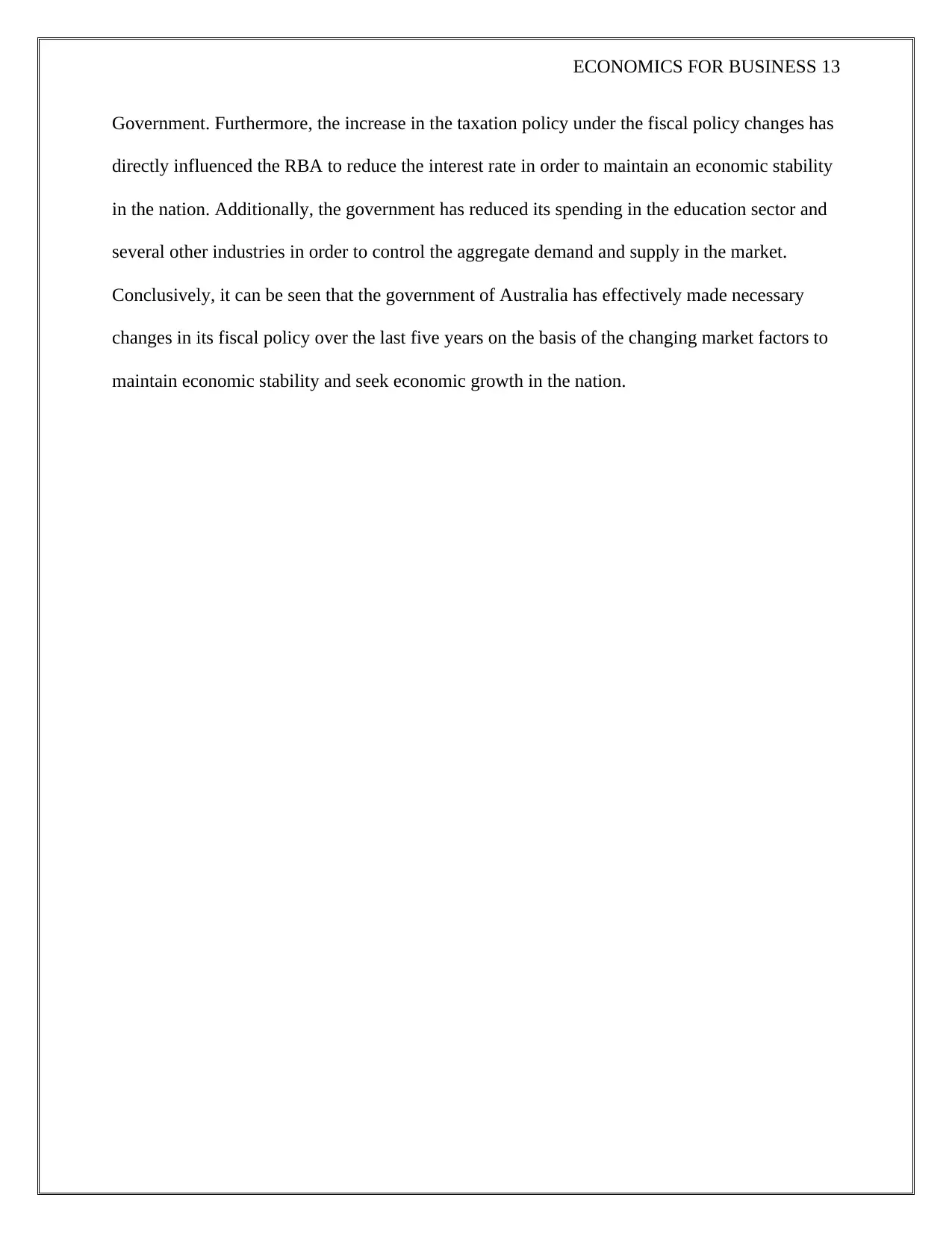
ECONOMICS FOR BUSINESS 13
Government. Furthermore, the increase in the taxation policy under the fiscal policy changes has
directly influenced the RBA to reduce the interest rate in order to maintain an economic stability
in the nation. Additionally, the government has reduced its spending in the education sector and
several other industries in order to control the aggregate demand and supply in the market.
Conclusively, it can be seen that the government of Australia has effectively made necessary
changes in its fiscal policy over the last five years on the basis of the changing market factors to
maintain economic stability and seek economic growth in the nation.
Government. Furthermore, the increase in the taxation policy under the fiscal policy changes has
directly influenced the RBA to reduce the interest rate in order to maintain an economic stability
in the nation. Additionally, the government has reduced its spending in the education sector and
several other industries in order to control the aggregate demand and supply in the market.
Conclusively, it can be seen that the government of Australia has effectively made necessary
changes in its fiscal policy over the last five years on the basis of the changing market factors to
maintain economic stability and seek economic growth in the nation.
Paraphrase This Document
Need a fresh take? Get an instant paraphrase of this document with our AI Paraphraser
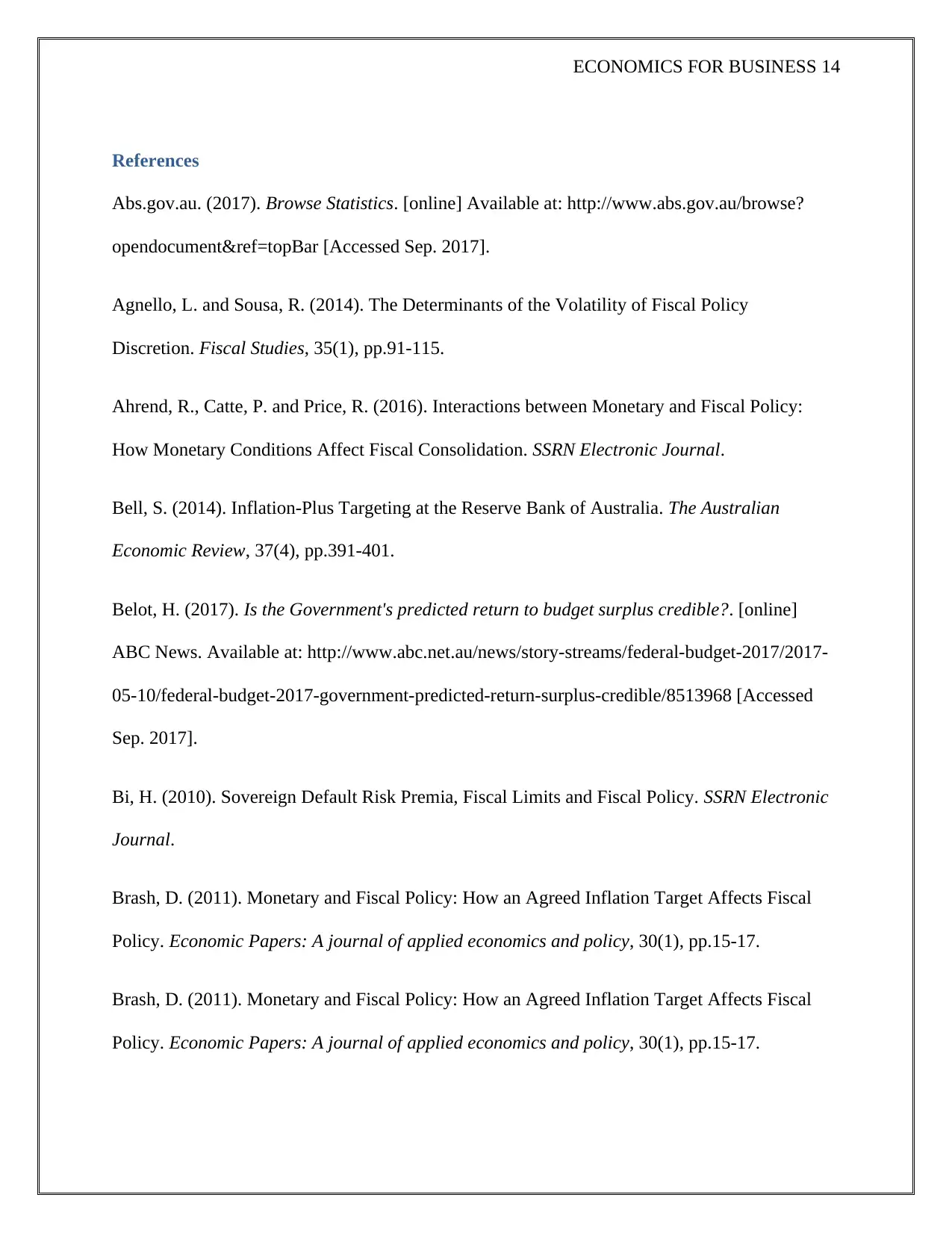
ECONOMICS FOR BUSINESS 14
References
Abs.gov.au. (2017). Browse Statistics. [online] Available at: http://www.abs.gov.au/browse?
opendocument&ref=topBar [Accessed Sep. 2017].
Agnello, L. and Sousa, R. (2014). The Determinants of the Volatility of Fiscal Policy
Discretion. Fiscal Studies, 35(1), pp.91-115.
Ahrend, R., Catte, P. and Price, R. (2016). Interactions between Monetary and Fiscal Policy:
How Monetary Conditions Affect Fiscal Consolidation. SSRN Electronic Journal.
Bell, S. (2014). Inflation-Plus Targeting at the Reserve Bank of Australia. The Australian
Economic Review, 37(4), pp.391-401.
Belot, H. (2017). Is the Government's predicted return to budget surplus credible?. [online]
ABC News. Available at: http://www.abc.net.au/news/story-streams/federal-budget-2017/2017-
05-10/federal-budget-2017-government-predicted-return-surplus-credible/8513968 [Accessed
Sep. 2017].
Bi, H. (2010). Sovereign Default Risk Premia, Fiscal Limits and Fiscal Policy. SSRN Electronic
Journal.
Brash, D. (2011). Monetary and Fiscal Policy: How an Agreed Inflation Target Affects Fiscal
Policy. Economic Papers: A journal of applied economics and policy, 30(1), pp.15-17.
Brash, D. (2011). Monetary and Fiscal Policy: How an Agreed Inflation Target Affects Fiscal
Policy. Economic Papers: A journal of applied economics and policy, 30(1), pp.15-17.
References
Abs.gov.au. (2017). Browse Statistics. [online] Available at: http://www.abs.gov.au/browse?
opendocument&ref=topBar [Accessed Sep. 2017].
Agnello, L. and Sousa, R. (2014). The Determinants of the Volatility of Fiscal Policy
Discretion. Fiscal Studies, 35(1), pp.91-115.
Ahrend, R., Catte, P. and Price, R. (2016). Interactions between Monetary and Fiscal Policy:
How Monetary Conditions Affect Fiscal Consolidation. SSRN Electronic Journal.
Bell, S. (2014). Inflation-Plus Targeting at the Reserve Bank of Australia. The Australian
Economic Review, 37(4), pp.391-401.
Belot, H. (2017). Is the Government's predicted return to budget surplus credible?. [online]
ABC News. Available at: http://www.abc.net.au/news/story-streams/federal-budget-2017/2017-
05-10/federal-budget-2017-government-predicted-return-surplus-credible/8513968 [Accessed
Sep. 2017].
Bi, H. (2010). Sovereign Default Risk Premia, Fiscal Limits and Fiscal Policy. SSRN Electronic
Journal.
Brash, D. (2011). Monetary and Fiscal Policy: How an Agreed Inflation Target Affects Fiscal
Policy. Economic Papers: A journal of applied economics and policy, 30(1), pp.15-17.
Brash, D. (2011). Monetary and Fiscal Policy: How an Agreed Inflation Target Affects Fiscal
Policy. Economic Papers: A journal of applied economics and policy, 30(1), pp.15-17.
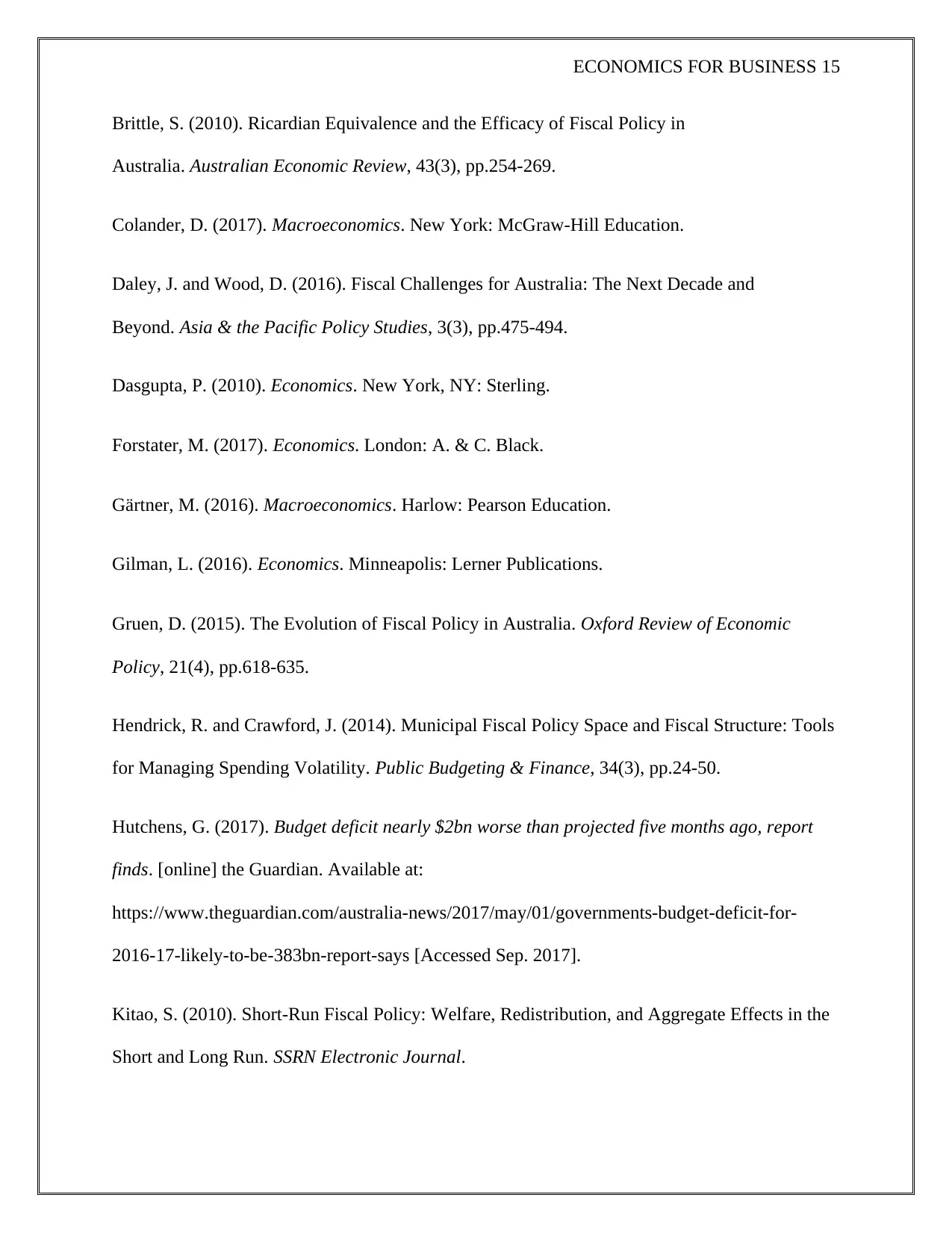
ECONOMICS FOR BUSINESS 15
Brittle, S. (2010). Ricardian Equivalence and the Efficacy of Fiscal Policy in
Australia. Australian Economic Review, 43(3), pp.254-269.
Colander, D. (2017). Macroeconomics. New York: McGraw-Hill Education.
Daley, J. and Wood, D. (2016). Fiscal Challenges for Australia: The Next Decade and
Beyond. Asia & the Pacific Policy Studies, 3(3), pp.475-494.
Dasgupta, P. (2010). Economics. New York, NY: Sterling.
Forstater, M. (2017). Economics. London: A. & C. Black.
Gärtner, M. (2016). Macroeconomics. Harlow: Pearson Education.
Gilman, L. (2016). Economics. Minneapolis: Lerner Publications.
Gruen, D. (2015). The Evolution of Fiscal Policy in Australia. Oxford Review of Economic
Policy, 21(4), pp.618-635.
Hendrick, R. and Crawford, J. (2014). Municipal Fiscal Policy Space and Fiscal Structure: Tools
for Managing Spending Volatility. Public Budgeting & Finance, 34(3), pp.24-50.
Hutchens, G. (2017). Budget deficit nearly $2bn worse than projected five months ago, report
finds. [online] the Guardian. Available at:
https://www.theguardian.com/australia-news/2017/may/01/governments-budget-deficit-for-
2016-17-likely-to-be-383bn-report-says [Accessed Sep. 2017].
Kitao, S. (2010). Short-Run Fiscal Policy: Welfare, Redistribution, and Aggregate Effects in the
Short and Long Run. SSRN Electronic Journal.
Brittle, S. (2010). Ricardian Equivalence and the Efficacy of Fiscal Policy in
Australia. Australian Economic Review, 43(3), pp.254-269.
Colander, D. (2017). Macroeconomics. New York: McGraw-Hill Education.
Daley, J. and Wood, D. (2016). Fiscal Challenges for Australia: The Next Decade and
Beyond. Asia & the Pacific Policy Studies, 3(3), pp.475-494.
Dasgupta, P. (2010). Economics. New York, NY: Sterling.
Forstater, M. (2017). Economics. London: A. & C. Black.
Gärtner, M. (2016). Macroeconomics. Harlow: Pearson Education.
Gilman, L. (2016). Economics. Minneapolis: Lerner Publications.
Gruen, D. (2015). The Evolution of Fiscal Policy in Australia. Oxford Review of Economic
Policy, 21(4), pp.618-635.
Hendrick, R. and Crawford, J. (2014). Municipal Fiscal Policy Space and Fiscal Structure: Tools
for Managing Spending Volatility. Public Budgeting & Finance, 34(3), pp.24-50.
Hutchens, G. (2017). Budget deficit nearly $2bn worse than projected five months ago, report
finds. [online] the Guardian. Available at:
https://www.theguardian.com/australia-news/2017/may/01/governments-budget-deficit-for-
2016-17-likely-to-be-383bn-report-says [Accessed Sep. 2017].
Kitao, S. (2010). Short-Run Fiscal Policy: Welfare, Redistribution, and Aggregate Effects in the
Short and Long Run. SSRN Electronic Journal.
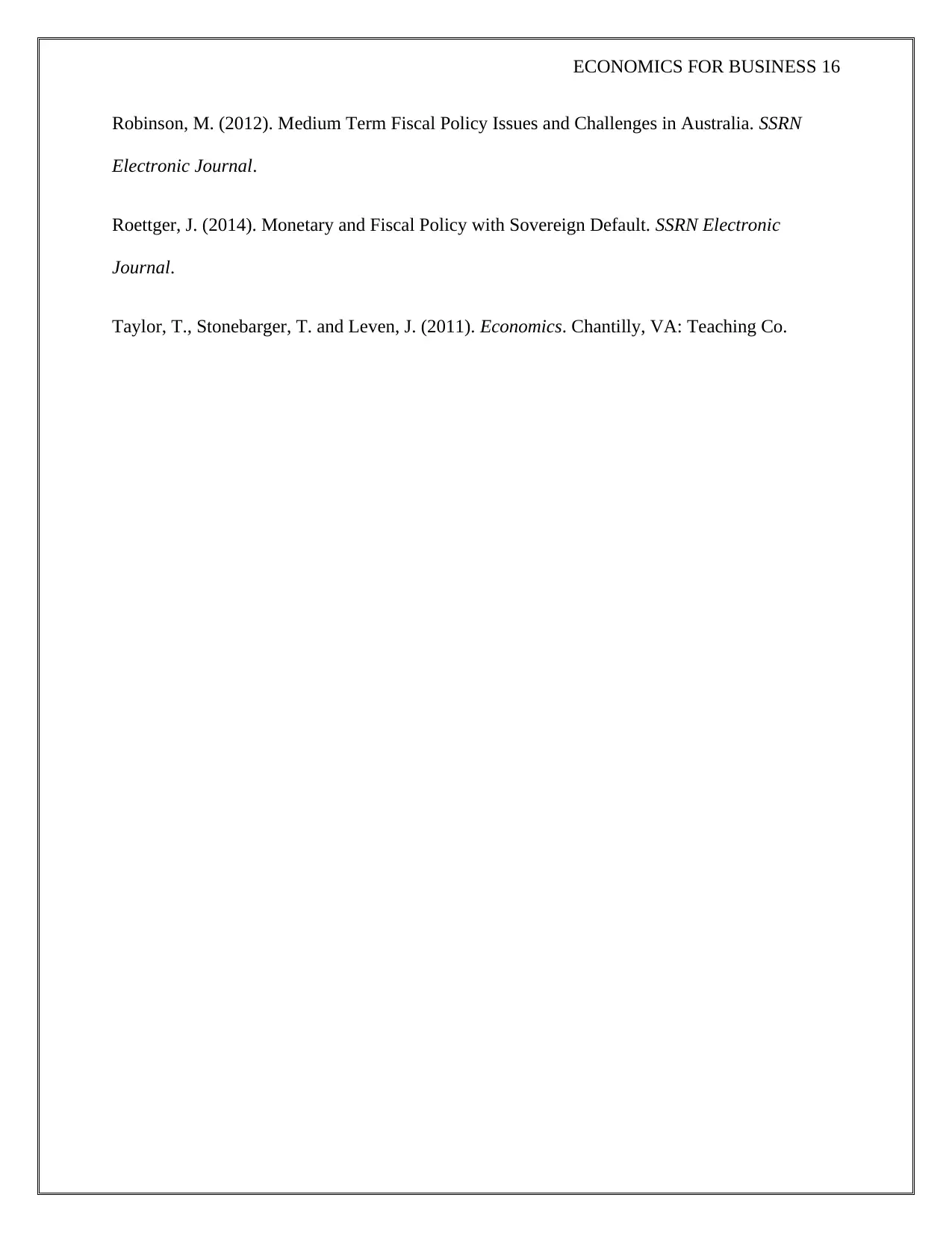
ECONOMICS FOR BUSINESS 16
Robinson, M. (2012). Medium Term Fiscal Policy Issues and Challenges in Australia. SSRN
Electronic Journal.
Roettger, J. (2014). Monetary and Fiscal Policy with Sovereign Default. SSRN Electronic
Journal.
Taylor, T., Stonebarger, T. and Leven, J. (2011). Economics. Chantilly, VA: Teaching Co.
Robinson, M. (2012). Medium Term Fiscal Policy Issues and Challenges in Australia. SSRN
Electronic Journal.
Roettger, J. (2014). Monetary and Fiscal Policy with Sovereign Default. SSRN Electronic
Journal.
Taylor, T., Stonebarger, T. and Leven, J. (2011). Economics. Chantilly, VA: Teaching Co.
1 out of 16
Related Documents
Your All-in-One AI-Powered Toolkit for Academic Success.
+13062052269
info@desklib.com
Available 24*7 on WhatsApp / Email
![[object Object]](/_next/static/media/star-bottom.7253800d.svg)
Unlock your academic potential
© 2024 | Zucol Services PVT LTD | All rights reserved.





